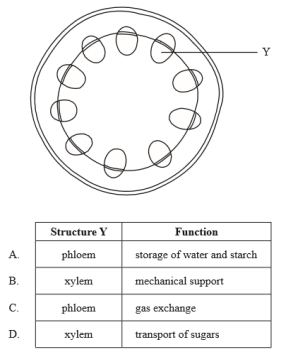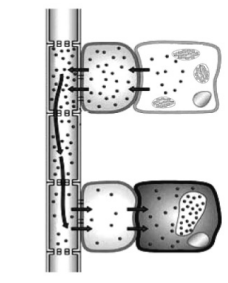IB Bio HL Plant Transport
1/28
Earn XP
Description and Tags
Name | Mastery | Learn | Test | Matching | Spaced |
|---|
No study sessions yet.
29 Terms
What is transported in xylem tissue
Water from roots to leaves
Which abiotic factors affect transpiration in plants?
temperature, humidity and wind
A man attaches a bird box to the trunk of a dicotyledonous tree. A few years later he returns to the tree and finds that his bird box is still attached and the tree is much taller. How high will his bird box be from the ground?
Unchanged as growth from the apical meristem would be above the box.
What is a role of xylem?
It contributes to the plant support with lignified walls.

The diagram below shows a cross section of a stem. What is the structure labelled Y and one of its functions?
Xylem- Mechanical Support

The diagram below shows part of the vascular system of a dicotyledonous plant. Which process is indicated by the arrows?
Active translocation of sucrose from the source to the sink in the phloem
How do mineral ions in the soil move into the root?
Mass flow of water
Angiospermophyta have vascular tissue (xylem and phloem) that bryophyta lack. Suggest advantages that vascular tissue confers
would make it easier to stand upright (against gravity)/structural support / allows (angiospermophytes) to be bigger;
could put leaves higher in the air to get more sunlight;
transport of water supply/nutrients from roots to other tissues;
could (more efficiently) transport/translocate sugars/food from leaves for storage;
Explain how abiotic factors affect the rate of transpiration in terrestrial plants.
a. less transpiration/water loss as (atmospheric) humidity rises;
b. air spaces inside leaf are saturated/nearly saturated (with water vapour);
c. smaller concentration gradient with higher atmospheric humidity;
d. more transpiration/water loss as temperature rises/with more heat;
e. faster diffusion / more kinetic energy (of water molecules);
f. faster evaporation (due to more latent heat available);
g. more transpiration/water loss as wind (speed) increases;
h. humid air/water vapour blown away from the leaf;
i. increasing the concentration gradient (of water vapour);
j. more transpiration/water loss in the light;
k. light causes stomata to open / stomata closed in darkness;
l. low CO concentration inside leaf in bright light so stomata open wider;
Describe the importance of water to living organisms.
a. coolant in sweat/in transpiration;
b. water has a high heat of vaporisation / heat taken when hydrogen bonds break;
c. water is cohesive so can pulled up/so can be moved under tension in xylem;
d. water is an excellent/universal solvent/dissolves many different substances;
e. medium for transport in blood/xylem/phloem;
f. medium for metabolic reactions / (metabolic) reactions happen dissolved in water;
g. surface tension due to cohesion allows organisms to live on water surface;
h. water has high heat capacity so much energy required to change its temperature;
i. ice floats so lakes/oceans do not freeze allowing life under the ice;
j. high heat capacity so stable habitat/so temperature of water changes slowly;
k. used in chemical reactions/photosynthesis/hydrolysis in organisms;
Explain how minerals move into plants.
a. minerals bound to soil particles;
b. examples of three nutrients from: phosphate, nitrate, magnesium, iron, calcium, potassium, sodium, magnesium;
c. minerals dissolve in water;
d. mass flow causes movement of minerals with movement of water through soil;
e. minerals diffuse down a concentration gradient towards roots (as the mineral concentration next to the roots is continuously decreasing);
f. minerals enter the plant through roots;
g. by active transport / use of ATP;
h. branching of roots increases surface area for absorption of minerals;
i. root hairs increase surface area (for the absorption of minerals);
j. hypha of (mutualistic) fungi may enhance movement of selected ions into roots / increase surface area;
k. root hairs have many mitochondria to provide energy/ATP for active transport;
l. export of H+ creates electrochemical gradient / displaces ions bound to soil/clay;
m. that causes positive mineral ions to diffuse into (root) cells;
n. negative mineral ions cross membrane linked to H+ ions moving down (H+) gradient;
Explain the light-independent processes of photosynthesis in plants.
a. occurs in stroma (of chloroplast);
b. energy/ATP and NADPH provided by the light-dependent reactions;
c. Calvin cycle;
d. carbon dioxide fixed to RuBP / carboxylation of RuBP/ribulose bisphosphate;
e. by RuBP carboxylase/rubisco;
f. forms unstable 6C compound / forms 6C compound which splits;
g. glycerate 3-phosphate (is produced by carbon fixation);
h. (glycerate phosphate) to triose phosphate/3C sugar by reduction/adding hydrogen;
i. using NADPH/reduced NADP;
j. triose phosphate/3C sugar converted to form hexose/glucose (phosphate);
k. most/ / of triose phosphate used for regeneration of RuBP;
l. ATP used to regenerate RUBP/convert glycerate 3-phosphate to triose phosphate;
Outline how and where energy is stored in plants.
a. glucose (from photosynthesis) stored as starch;
b. starch stored (as granules) in chloroplast/in plastids;
c. (starch stored) in seeds/storage roots/stem tubers;
d. stored as lipids/oils;
e. (lipid/oils storage) in seeds;
f. lipids store twice as much energy per gram as starch;
Describe how water is carried through a flowering plant.
a. active transport of solutes from soil into roots;
b. draws water by osmosis
c. root hairs provide a large surface area for water uptake;
d. carried through xylem vessels;
e. transpiration is the loss of water (vapour) from leaves and stems / stomata;
f. (transpiration) creates suction/pull/negative pressure;
g. cellulose wall with rings of lignin give strength to resist (low) pressure;
h. water pulled up due to capillary action/cohesion/adhesion;
i. continuous column of molecules/transpiration stream;
Describe how plants carry out gas exchange in the leaves.
gases/O and CO enter/exit the leaf through the stomata;
by diffusion / down the concentration gradient;
photosynthesis maintains concentration gradients/high O and low CO in the leaf;
guard cells open the stomata during the day / close the stomata at night;
gases/O /CO move through air spaces in the spongy (mesophyll);
CO dissolves in moisture in (mesophyll) cell walls;
Describe how water is carried by the transpiration stream.
transpiration is water loss (from plant) by evaporation; flow of water through xylem from roots to leaves is the transpiration stream;
evaporation from spongy mesophyll cells;
replaced by osmosis from the xylem;
(diffusion of water vapour) through stomata;
water lost replaced from xylem / clear diagram showing movement of water from xylem through cell(s) (walls) to air space;
water pulled out of xylem creates suction/low pressure/tension;
transpiration pull results;
water molecules stick together/are cohesive;
due to hydrogen bonding/polarity of water molecules;
xylem vessels are thin (hollow) tubes; adhesion between water and xylem due to polarity of water molecules;
creates continuous column/transpiration stream;
Define the term transpiration and explain the factors that can affect transpiration in a typical terrestrial plant.
(transpiration is) loss of water vapour from the leaves/stomata (and stems) of plants;
temperature, humidity, light (intensity) and wind all affect transpiration;
high temperatures increase evaporation rate of water/transpiration;
(accept converse) high humidity lowers the rate of water evaporation/transpiration;
(accept converse) air currents/wind increase water evaporation/transpiration;
(accept converse) high light (intensity)/sunlight (usually) increases photosynthesis/water evaporation through the stomata/transpiration;
stomata open to allow gaseous exchange/entry of CO ;
abscisic acid stimulates closing of stomata; guard cells open/close the stomata;
adaptations of (xerophyte) plant structures reduce water loss/transpiration; one example;
(thicker leaf cuticle / reduced surface area/rolled leaves/spines / sunken/reduced stomata / close stomata in day / low growth form / CAM / C4 physiology) second example;
(of above) Award [8 max] if definition is missing
Explain how water is moved from roots to leaves in terrestrial plants
water enters roots through the root hairs by osmosis; root hairs provide an extended surface area (for active transport and osmosis);
active transport of ions from soil into the roots (enhances osmotic pressure);
osmotic pressure moves water into the xylem;
water is carried (in a transpiration stream) in the xylem;
adhesion of water to the inside of the xylem helps move water up;
cohesion of water to itself enhances water movement up the xylem;
water diffuses into air spaces (in spongy mesophyll) of leaves;
it passes out through the stomata by evaporation/transpiration;
evaporation sets up a transpiration pull that keeps the water moving; guard cells control the rate of transpiration pull/evaporation;
xylem vessels are tubes with helical rings to enhance water movement/resist low pressure;
Outline how three properties of water enhance its use by living organisms.
cohesive properties help in transpiration pull/movement of water in plants;
high surface tension allows some animals to stride across its surface;
high latent heat of evaporation/large amounts of energy required for evaporation makes it a good coolant;
high specific heat capacity causes it to maintain environmental temperatures;
low density as ice forms insulation of lakes allowing life below;
transparency for photosynthesis; transparency for vision in animals;
solvent properties make it the medium for metabolic reactions;
solvent properties allow transport of (soluble) molecules/food;
Translocation
This is the process by which nutrients, particularly sugars (mainly sucrose), are moved through the phloem from sources (where they are produced or stored) to sinks (where they are used or stored).
Source
A source is any part of the plant that produces or releases sugars. Common sources include leaves (where photosynthesis occurs) and storage organs like roots or tubers during times when the plant is not actively growing.
Sink
A sink is any part of the plant that consumes or stores sugars. Examples include growing tissues (like roots, fruits, and developing leaves) and storage organs that need sugars for growth and energy.
Companion Cell
Companion cells are specialized cells found in the phloem that assist sieve tube members in the transport of nutrients. They are connected to sieve tube members by plasmodesmata and help regulate the flow of substances, providing metabolic support.
Sieve Tube Member
These are the primary conducting cells of the phloem. They are elongated and have perforated end walls (sieve plates) that facilitate the flow of sap. Sieve tube members lack a nucleus and rely on companion cells for their metabolic functions
Pressure-Flow Model
This model explains how phloem sap moves through the plant. It suggests that sugars are actively transported into sieve tubes at the source, creating a high osmotic pressure that draws water in, leading to a buildup of pressure. This pressure drives the flow of sap towards sinks, where sugars are removed, reducing pressure and allowing more sap to flow in from the source.
Absisic Acid
Causes Stomata to close
State two types of meristems found in plants.
apical and lateral
State two methods by which terrestrial plants support themselves.
cellulose cell wall/turgor/ lignin/lignified xylem
What generates new cells in dicotyledonous plants?
I. Apical Meristems
II. Lateral meristems
III. Phloem
C) I and II only
apical and lateral meristems